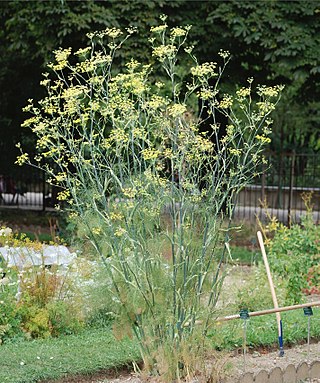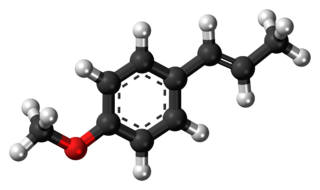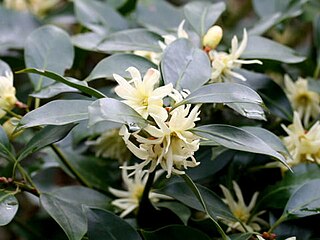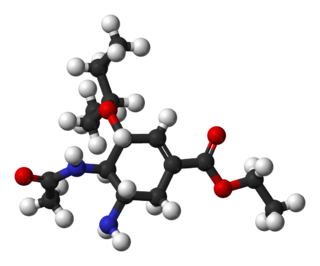
Five-spice powder is a spice mixture of five or more spices used predominantly in almost all branches of Chinese cuisine. The five flavors of the spices refers to the five traditional Chinese elements. The addition of eight other spices creates thirteen-spice powder (十三香),which is used less commonly.

Anise,also called aniseed or rarely anix,is a flowering plant in the family Apiaceae native to the eastern Mediterranean region and Southwest Asia.

Fennel is a flowering plant species in the carrot family. It is a hardy,perennial herb with yellow flowers and feathery leaves. It is indigenous to the shores of the Mediterranean but has become widely naturalized in many parts of the world,especially on dry soils near the sea coast and on riverbanks.

Oseltamivir,sold under the brand name Tamiflu,is an antiviral medication used to treat and prevent influenza A and influenza B,viruses that cause the flu. Many medical organizations recommend it in people who have complications or are at high risk of complications within 48 hours of first symptoms of infection. They recommend it to prevent infection in those at high risk,but not the general population. The Centers for Disease Control and Prevention (CDC) recommends that clinicians use their discretion to treat those at lower risk who present within 48 hours of first symptoms of infection. It is taken by mouth,either as a pill or liquid.

Anethole is an organic compound that is widely used as a flavoring substance. It is a derivative of the aromatic compound allylbenzene and occurs widely in plants in essential oils. It is in the class of phenylpropanoid organic compounds. It contributes a large component of the odor and flavor of anise and fennel,anise myrtle (Myrtaceae),liquorice (Fabaceae),magnolia blossoms,and star anise (Schisandraceae). Closely related to anethole is its isomer estragole,which is abundant in tarragon (Asteraceae) and basil (Lamiaceae),and has a flavor reminiscent of anise. It is a colorless,fragrant,mildly volatile liquid. Anethole is only slightly soluble in water but exhibits high solubility in ethanol. This trait causes certain anise-flavored liqueurs to become opaque when diluted with water;this is called the ouzo effect.
Shikimic acid,more commonly known as its anionic form shikimate,is a cyclohexene,a cyclitol and a cyclohexanecarboxylic acid. It is an important biochemical metabolite in plants and microorganisms. Its name comes from the Japanese flower shikimi,from which it was first isolated in 1885 by Johan Fredrik Eykman. The elucidation of its structure was made nearly 50 years later.

Illicium anisatum,with common names Japanese star anise,Aniseed tree,and sacred Anise tree,known in Japanese as shikimi,is an evergreen shrub or small tree closely related to the Chinese star anise. Since it is highly toxic,the fruit is not edible;instead,the dried and powdered leaves are burned as incense in Japan. Its branches and evergreen leaves are considered highly sacred by Japanese Buddhists due to aversion from insects and their ability to remain fresh after pruning.

Illicium is a genus of flowering plants treated as part of the family Schisandraceae,or alternately as the sole genus of the Illiciaceae. It has a disjunct distribution,with most species native to eastern Asia and several in parts of North America,including the southeastern United States,Mexico,and the Caribbean. General common names include star anise and anisetree. The genus name comes from the Latin illicere.

Illiciaceae A.C.Sm. was a family of flowering plants recognized in a number of systems of plant taxonomy. The Illiciaceae is not recognized as a distinct family by the APG III system of plant taxonomy,the most well accepted system in use today.

Oseltamivir total synthesis concerns the total synthesis of the antiinfluenza drug oseltamivir marketed by Hoffmann-La Roche under the trade name Tamiflu. Its commercial production starts from the biomolecule shikimic acid harvested from Chinese star anise and from recombinant E. coli. Control of stereochemistry is important:the molecule has three stereocenters and the sought-after isomer is only 1 of 8 stereoisomers.

Illicium floridanum is an evergreen shrub native to the Gulf Coast area of the Southern United States,from Florida to Louisiana.

Anisatin is an extremely toxic,insecticidally active component of the shikimi plant. The lethal dose is 1 mg/kg (i.p.) in mice. Symptoms begin to appear about 1–6 hours after ingestion,beginning with gastrointestinal ailments,such as diarrhea,vomiting,and stomach pain,followed by nervous system excitation,seizures,loss of consciousness,and respiratory paralysis,which is the ultimate cause of death.

Aminoshikimic acid is a synthetic crystalline carboxylic acid. It is characterized by multiple stereogenic centers and functional groups arrayed around a six-membered carbocyclic ring. Aminoshikimic acid is also an alternative to shikimic acid as a starting material for the synthesis of neuraminidase inhibitors such as the antiinfluenza agent oseltamivir (Tamiflu).

Merrilactone A is one of the four sesquiterpenes that were newly discovered from the fruit of Illicium merrillianum in 2000. Members of the genus Illicium include Chinese star anise,widely used as a spice for flavouring food and beverages,and also poisonous plants such as Japanese star anise. Chemical studies of Illicium have developed rapidly over the last 20 years,and merrilactone A has been shown to have neurotrophic activity in fetal rat cortical neuron cultures. This has led researchers to believe that Merrilactone A may hold therapeutic potential in the treatment of neuro-degenerative diseases such as Alzheimer's disease and Parkinson's disease.
Star anise refers to Illicium verum Chinese star anise,and the spice derived from it. It can also refer to related poisonous plants:

Johan Fredrik Eykman or Johann Frederik Eijkman was a Dutch chemist.

Cumin is a flowering plant in the family Apiaceae,native to the Irano-Turanian Region. Its seeds –each one contained within a fruit,which is dried –are used in the cuisines of many cultures in both whole and ground form. Although cumin is used in traditional medicine,there is no high-quality evidence that it is safe or effective as a therapeutic agent.

Methoxyeugenol is a naturall occurring allylbenzene and eugenol derivative. It is found in toxic Japanese star anise pericarp and leaves. as well as in nutmeg crude extract but not in nutmeg essential oil. It also activates PPAR-gamma in vivo.



















